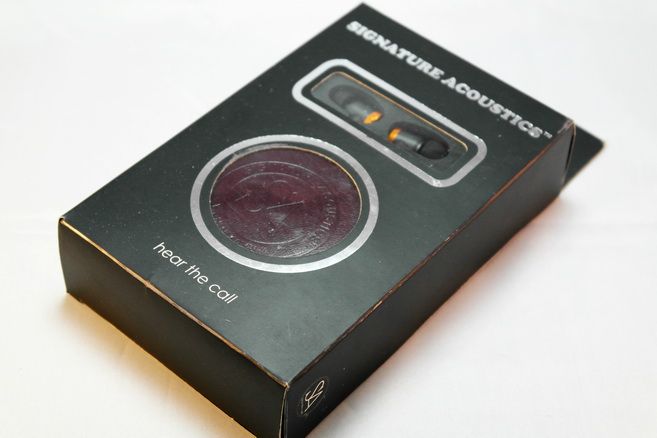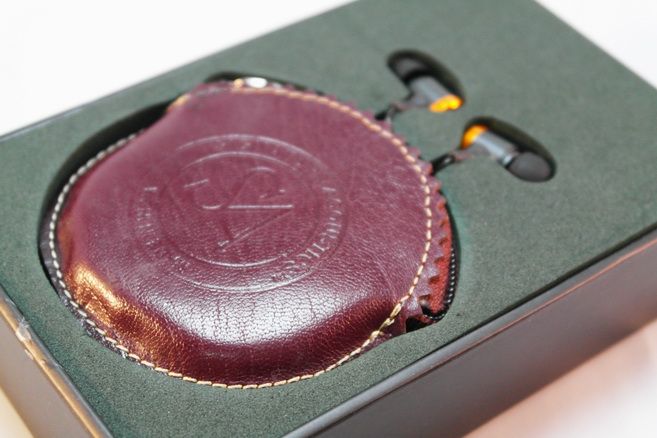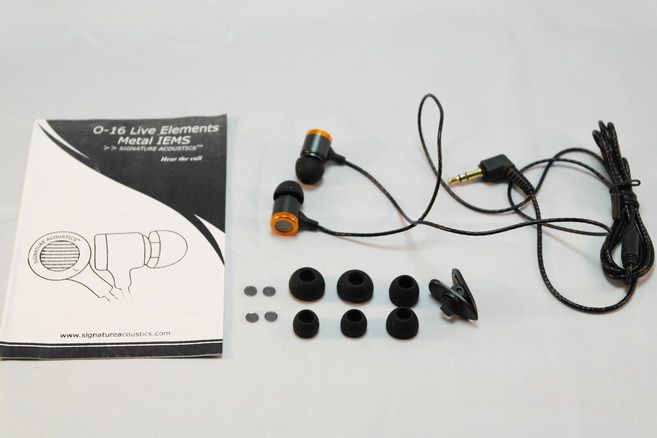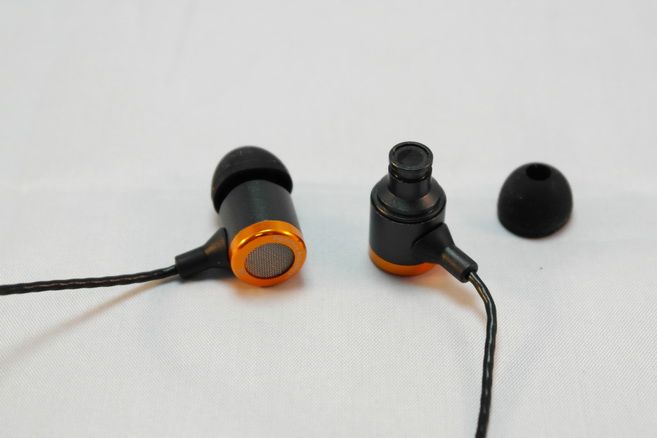Preamble:
Before Faheem contacted me on Head-Fi and introduced me to the company and asked if I was interested in checking out their recent and upcoming products, I never heard of the Indian audio company “Signature Acoustics”.
In 2011, a group of enthusiasts and reviewers of the Indian hi-fi distributor Pristine Note decided to found their own headphone company, Signature Acoustics (http://www.signatureacoustics.com/). They sell their in-ears in India, but also world-wide.
Faheem then kindly arranged the shipment of their three models, the current C-12, O-16 and the upcoming Be-09 for my honest evaluation. I have then merged the three reviews into one for a better overview.
Technical Specifications:
C-12 Wooden:
O-16 Metal:
MSRP: ~$55
Type: Open back
Driver: 8 mm (CCAW)
Impedance: 17 Ohms @ 1 kHz
Frequency: 12 to 22 kHz
Sensitivity: 102 dB
Total length: 1.2 m (split length 28 cm)
Channel Balance: < 2.5% dB @ 1 kHz
Connector: 3.5mm Gold Plated Stereo Pin
Be-09:
Delivery Content:
C-12 Wooden:
O-16 Metal:
See Be-09 (the test sample arrived only in a clear plastic bag with the medium silicone tips).
Be-09:
Looks, Feels, Build Quality:
C-12 Wooden:
O-16 Metal:
Just as the name says, the in-ear bodies are made of metal and have got a good build quality. The faceplate features a silver metal mesh which is surrounded by an orange metal ring which contains the Signature Acoustics lettering as well as the side markers.
The cable is the same as the one that is used for the C-12, though the coating seems to be a bit thinner, hence the cable is more flexible.
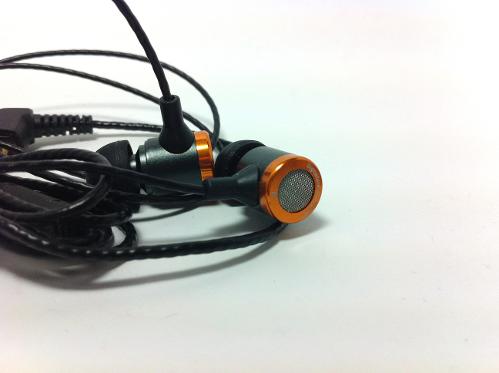
Be-09:
Comfort, Isolation:
All three in-ears have got the same good wearing comfort but strong microphonics as well when they are worn with the cables straight down. However, microphonics can be reduced by a strong amount by guiding the cables over the ears, which works very well as the in-ears are fairly small. This drastically reduces microphonics, but they could be even completely eliminated if there was a chin-slider.
C-12 Wooden:
O-16 Metal:
As the O-16’s back side is completely open and only covered by a silver metal mesh, isolation is only barely present as a consequence of it.
Be-09:
Sound:
The in-ears were burnt in (just in case) before I started listening and testing. Source devices were mainly the LH Labs Geek Out IEM 100 on the computer as well as the iBasso DX80 and Shanling M2.
Tonality:
C-12 Wooden:
O-16 Metal:
I’d consider the sound as being warm and bass-oriented.
Bass alongside with the ground-tone is emphasised by about 10 dB compared to a flat IEM and gives the O-16 a warm and smooth character. The emphasis goes evenly from the sub- over the mid- and upper bass and starts evenly rolling off from the upper lower ground-tone on, into the upper ground-tone, where it still bleeds in a bit.
Mids are present and more on the warmer side; voices however sound quite good, without too much warmth, although a certain amount of warmness and sweetness can’t be denied.
Presence area is recessed and guarantees for strenuousness-free listening. There is a small peak at 5.6 kHz in my ears, else the treble is soft and in the background.
Be-09:
Resolution:
C-12 Wooden:
O-16 Metal:
Here, the resolution is on a really good level. Mids as well as treble are high resolving, with a good amount of details and precisely differentiated instruments, although voices are minimally veiled.
Bass is (comparatively) fast, although rather on the soft side. Fast double- and triple-bass punches are still recognisable as such, although I wouldn’t mind more aridness.
Be-09:
Soundstage:
C-12 Wooden:
O-16 Metal:
The soundstage extends very wide and deep and is very spacious. Its dimensions remind me of soundstage monsters like the Brainwavz R1, Sennheiser IE 80 or KZ ZN1.
Instrument separation could be a bit better and so there is not too much space between single instruments, but that is really nothing to blame the IEMs for at this price.
Be-09:
Conclusion:
The O-16 is definitely the strongest IEM out of the Signature Acoustics line-up. The sound is warm and bassy, but quite controlled and resolution is quite high as well, although the lows could be more arid. The in-ears only barely isolate ambient noise which could be a problem for some.
The soundstage these in-ears generate is very spacious and outstanding.
The build quality is quite excellent. The accessories (carrying care) are good.
Overall, I give the O-16 77.5% or rounded 4 out of 5 stars.
Before Faheem contacted me on Head-Fi and introduced me to the company and asked if I was interested in checking out their recent and upcoming products, I never heard of the Indian audio company “Signature Acoustics”.
In 2011, a group of enthusiasts and reviewers of the Indian hi-fi distributor Pristine Note decided to found their own headphone company, Signature Acoustics (http://www.signatureacoustics.com/). They sell their in-ears in India, but also world-wide.
Faheem then kindly arranged the shipment of their three models, the current C-12, O-16 and the upcoming Be-09 for my honest evaluation. I have then merged the three reviews into one for a better overview.
Technical Specifications:
C-12 Wooden:
MSRP: ~$40
Driver: 8 mm (CCAW)
Impedance: 18 Ohms @ 1 kHz
Frequency: 17 to 20 kHz
Sensitivity: 102 dB
Total length: 1.2 m (split length 28 cm)
Channel Balance: < 2.5% dB @ 1 kHz
Driver: 8 mm (CCAW)
Impedance: 18 Ohms @ 1 kHz
Frequency: 17 to 20 kHz
Sensitivity: 102 dB
Total length: 1.2 m (split length 28 cm)
Channel Balance: < 2.5% dB @ 1 kHz
O-16 Metal:
MSRP: ~$55
Type: Open back
Driver: 8 mm (CCAW)
Impedance: 17 Ohms @ 1 kHz
Frequency: 12 to 22 kHz
Sensitivity: 102 dB
Total length: 1.2 m (split length 28 cm)
Channel Balance: < 2.5% dB @ 1 kHz
Connector: 3.5mm Gold Plated Stereo Pin
Be-09:
MSRP: ~$30
Type: Earphone with Mic (Headset) with Nokia/Apple configuration
Cable Adaptor 3.5mm Male to 3.5mm Female TRRS adapter.
Adapter Pinout: T-T, R1-R1, R2-S, S-R2. Ground and Mic are reversed, so it may be used for compatibility between Apple and Nokia type earphones.
Length: 1.2 m
Driver: 10 mm CCAW
Impedance: 17.5 Ohms
3.5 mm TRRS Gold plated pin
Type: Earphone with Mic (Headset) with Nokia/Apple configuration
Cable Adaptor 3.5mm Male to 3.5mm Female TRRS adapter.
Adapter Pinout: T-T, R1-R1, R2-S, S-R2. Ground and Mic are reversed, so it may be used for compatibility between Apple and Nokia type earphones.
Length: 1.2 m
Driver: 10 mm CCAW
Impedance: 17.5 Ohms
3.5 mm TRRS Gold plated pin
Delivery Content:
C-12 Wooden:
See Be-09 (the test sample arrived only in a clear plastic bag with the medium silicone tips).
O-16 Metal:
See Be-09 (the test sample arrived only in a clear plastic bag with the medium silicone tips).
Be-09:
The Be-09 arrives in a black packaging which has got two plastic screen windows on the front that allow you to take a look at the in-ears and the carrying case.
The back side contains a large company logo and a description of the company’s philosophy.
Opening the package, the in-ears and the delivery content, which consists of a cable clip, a real leather carrying case with the company logo, three pairs of silicone tips and a quick start guide get revealed.
The back side contains a large company logo and a description of the company’s philosophy.
Opening the package, the in-ears and the delivery content, which consists of a cable clip, a real leather carrying case with the company logo, three pairs of silicone tips and a quick start guide get revealed.
Looks, Feels, Build Quality:
C-12 Wooden:
The in-ears are made of really well manufactured real wood and have got an “SA” logo on their faceplate. The cable is twisted and then coated by a layer of plastic. The 3.5 mm plug is L-shaped, but a bit angled as well. Except for at the connector, there is almost no or only very stiff strain relief and no chin-slider.
The build quality of the in-ear bodies seems very good and valuable, but the cable could be more flexible and less springy.
The side markers (L/R) are only barely visible.

The build quality of the in-ear bodies seems very good and valuable, but the cable could be more flexible and less springy.
The side markers (L/R) are only barely visible.

O-16 Metal:
Just as the name says, the in-ear bodies are made of metal and have got a good build quality. The faceplate features a silver metal mesh which is surrounded by an orange metal ring which contains the Signature Acoustics lettering as well as the side markers.
The cable is the same as the one that is used for the C-12, though the coating seems to be a bit thinner, hence the cable is more flexible.

Be-09:
The new Be-09’s bodies are made of halfway shiny red and halfway black metal and appear to be well made as well, with large side markers on the bottom. The y-split is made of shiny red metal too and features a white Signature Acoustics logo, but also lacks a chin-slider. The straight 3.5 mm plug is made of black metal.
The cable is also twisted and then coated on this model and has no strain relief at the y-split, but a good one on the other cable transitions. The left side features a one-button remote control with built-in microphone.


The cable is also twisted and then coated on this model and has no strain relief at the y-split, but a good one on the other cable transitions. The left side features a one-button remote control with built-in microphone.


Comfort, Isolation:
All three in-ears have got the same good wearing comfort but strong microphonics as well when they are worn with the cables straight down. However, microphonics can be reduced by a strong amount by guiding the cables over the ears, which works very well as the in-ears are fairly small. This drastically reduces microphonics, but they could be even completely eliminated if there was a chin-slider.
C-12 Wooden:
Isolation is fairly high, as there is only a tiny vent in the in-ears’ bodies.
O-16 Metal:
As the O-16’s back side is completely open and only covered by a silver metal mesh, isolation is only barely present as a consequence of it.
Be-09:
Quite similar to the C-12, Be-09’s isolation is fairly high, but probably just a tad lower than on the wooden in-ears.
Sound:
The in-ears were burnt in (just in case) before I started listening and testing. Source devices were mainly the LH Labs Geek Out IEM 100 on the computer as well as the iBasso DX80 and Shanling M2.
Tonality:
C-12 Wooden:
The C-12 has got a bass-bloated, consumer oriented sounding with thick upper bass and a ground-tone that clearly bleeds into the mids. The massive emphasis of about 15 dB overshadows the mids when bass-heavy tracks are being played back.
Midbass, upper bass as well as the lower ground-tone are about on the same level. From midbass on, level starts decreasing evenly and just stops in the area of the mids. Sub-bass is somewhat rolled off, but still audibly present.
Mids are warm, thick, mellow and voluminous.
Treble is (except for some sparkle in the upper highs) in the background and makes the sound appear warm, coated and mellow along with the mighty ground-tone.
Midbass, upper bass as well as the lower ground-tone are about on the same level. From midbass on, level starts decreasing evenly and just stops in the area of the mids. Sub-bass is somewhat rolled off, but still audibly present.
Mids are warm, thick, mellow and voluminous.
Treble is (except for some sparkle in the upper highs) in the background and makes the sound appear warm, coated and mellow along with the mighty ground-tone.
O-16 Metal:
I’d consider the sound as being warm and bass-oriented.
Bass alongside with the ground-tone is emphasised by about 10 dB compared to a flat IEM and gives the O-16 a warm and smooth character. The emphasis goes evenly from the sub- over the mid- and upper bass and starts evenly rolling off from the upper lower ground-tone on, into the upper ground-tone, where it still bleeds in a bit.
Mids are present and more on the warmer side; voices however sound quite good, without too much warmth, although a certain amount of warmness and sweetness can’t be denied.
Presence area is recessed and guarantees for strenuousness-free listening. There is a small peak at 5.6 kHz in my ears, else the treble is soft and in the background.
Be-09:
Three words entirely describe the sound of the Be-09: “starkly v-shaped signature”.
Down from the upper middle ground-tone, level starts increasing the whole time down to the mid- and sub-bass where an immensely strong emphasis of about 16 dB can be heard. The upper bass is also strongly emphasised, but a bit less.
Mids are obviously in the background and rather on the bright side, but tonally quite well made – but even obviously in the background.
The following presence area is in the background; the treble features an even, but strong emphasis from 5.5 to 7.5 kHz, which sounds metallic, but not piercing because it is rather broad-banded.
Down from the upper middle ground-tone, level starts increasing the whole time down to the mid- and sub-bass where an immensely strong emphasis of about 16 dB can be heard. The upper bass is also strongly emphasised, but a bit less.
Mids are obviously in the background and rather on the bright side, but tonally quite well made – but even obviously in the background.
The following presence area is in the background; the treble features an even, but strong emphasis from 5.5 to 7.5 kHz, which sounds metallic, but not piercing because it is rather broad-banded.
Resolution:
C-12 Wooden:
For better evaluation of the resolution, I reduced the strongly emphasised areas with an equalizer.
The resolution of the C-12 is only modest, with veiled and coated mids and blunt, slow, unprecise lows, which is especially audible with fast music and tracks that have got a higher amount of bass (not to be mistaken with bass-emphasised music).
The resolution of the C-12 is only modest, with veiled and coated mids and blunt, slow, unprecise lows, which is especially audible with fast music and tracks that have got a higher amount of bass (not to be mistaken with bass-emphasised music).
O-16 Metal:
Here, the resolution is on a really good level. Mids as well as treble are high resolving, with a good amount of details and precisely differentiated instruments, although voices are minimally veiled.
Bass is (comparatively) fast, although rather on the soft side. Fast double- and triple-bass punches are still recognisable as such, although I wouldn’t mind more aridness.
Be-09:
Overall, the Be-09 is higher resolving than the C-12, but doesn’t reach the amount of details the O-16 has.
Treble is similarly resolving to the O-16’s, but mids don’t have as much details and sound “flat”. Although lows aren’t spongy, they are definitely on the softer side and fast bass-punches sound muddy.
All in all, I see the Be-09 a bit closer to the O-16 than to the C-12.
Treble is similarly resolving to the O-16’s, but mids don’t have as much details and sound “flat”. Although lows aren’t spongy, they are definitely on the softer side and fast bass-punches sound muddy.
All in all, I see the Be-09 a bit closer to the O-16 than to the C-12.
Soundstage:
C-12 Wooden:
The soundstage is averagely wide, but doesn’t really have a distinct or precise instrument separation. There is some spatial depth, but single layers are hard to detect.
O-16 Metal:
The soundstage extends very wide and deep and is very spacious. Its dimensions remind me of soundstage monsters like the Brainwavz R1, Sennheiser IE 80 or KZ ZN1.
Instrument separation could be a bit better and so there is not too much space between single instruments, but that is really nothing to blame the IEMs for at this price.
Be-09:
The soundstage is wider than the C-12’s and has also got more depth (but it is not as large as the O-16’s by any means). Instrument separation is surprisingly precise and about on the same level as the O-16.
Overall, I’d consider the soundstage as being well made.
Overall, I’d consider the soundstage as being well made.
Conclusion:
Not including personal preferences but only focussing on the technical strengths, I don’t find the C-12 Wooden that good. It is okay with slow recordings and doesn’t sound too strained with those, but loses control and sounds muddy as well as unprecise with fast music and tracks that have got more low-end. Overall resolution is unfortunately blunt as well, but there are at least no annoying peaks or valleys.
Except for the cable without strain relief, build quality is excellent and the included carrying case is good as well.
All in all, I come to a rating of 45% or barely rounded 2.5 out of 5 stars.
Except for the cable without strain relief, build quality is excellent and the included carrying case is good as well.
All in all, I come to a rating of 45% or barely rounded 2.5 out of 5 stars.
The O-16 is definitely the strongest IEM out of the Signature Acoustics line-up. The sound is warm and bassy, but quite controlled and resolution is quite high as well, although the lows could be more arid. The in-ears only barely isolate ambient noise which could be a problem for some.
The soundstage these in-ears generate is very spacious and outstanding.
The build quality is quite excellent. The accessories (carrying care) are good.
Overall, I give the O-16 77.5% or rounded 4 out of 5 stars.
The Be-09, Signature Acoustcs’ latest model, has got a classical “fun” sound signature with an immensely strong v-shape and typically pushed back mids.
Resolution is more or less decent, but doesn’t reach the level of the O-16. Soundstage is good as well, though not as large and precise as Signature Acoustics’ other metallic in-ears.
Build quality is very good and the handmade leather case is a nice addition.
Overall, I come to a concluding rating of 65% or rounded 3.5 out of 5 stars.
Resolution is more or less decent, but doesn’t reach the level of the O-16. Soundstage is good as well, though not as large and precise as Signature Acoustics’ other metallic in-ears.
Build quality is very good and the handmade leather case is a nice addition.
Overall, I come to a concluding rating of 65% or rounded 3.5 out of 5 stars.













